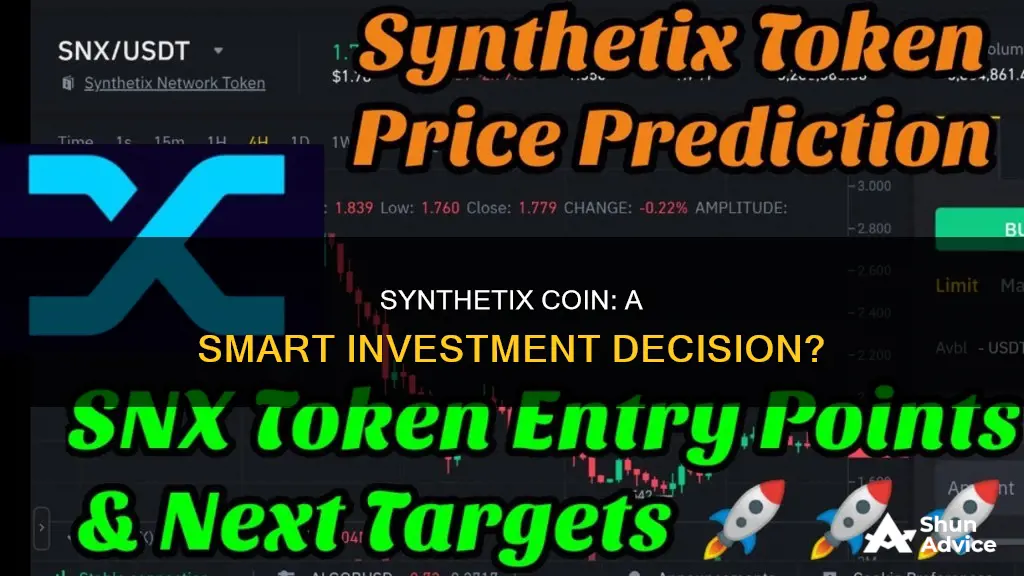
Synthetix is a DeFi protocol based on Ethereum that allows users to mint synthetic assets as tokens. It has become one of the most popular DeFi applications, with a value of over $2.5 billion locked in as of January 2020. Synthetix offers synthetic assets, which mirror financial instruments in the real world, such as derivatives. The SNX token is used as collateral against these synthetic assets. While Synthetix has seen success and has strong fundamentals, it is still a risky investment that is currently facing competition from other protocols that aren't constrained by Ethereum's limitations.
| Characteristics | Values |
|---|---|
| Type of Investment | Cryptocurrency |
| Token Name | Synthetix Network Token (SNX) |
| Technology | Blockchain-based derivatives liquidity protocol |
| Use Case | Minting and trading synthetic assets |
| Synthetic Assets | Financial instruments that mirror real-world assets |
| Synthetic Asset Creation | Requires SNX tokens as collateral |
| Synthetic Asset Trading | Can be traded on the Synthetix Exchange |
| Synthetic Asset Types | Currencies, cryptocurrencies, commodities, equities, indices |
| Advantages | Exposure to multiple instruments, no counterparty needed, infinite liquidity, fast settlement, low barriers to entry |
| Disadvantages | High Ethereum transaction fees, potential regulatory issues, centralization concerns |
| Price Volatility | High volatility, with significant price fluctuations since 2019 |
| Price Predictions | Varied predictions until 2030, ranging from $4.23 in 2025 to $17.98 in 2030 |
| Investment Risks | High risk due to development stage, potential competition, Ethereum dependence |
What You'll Learn
- Synthetix's SNX token has strong fundamentals and the protocol enjoys a first-mover advantage
- SNX's price has been highly volatile since its historical listing price
- Synthetix is a risky investment but has a higher probability of increasing in value
- SNX's staking returns and fee rewards make it a worthwhile investment
- Synthetix's centralization and potential regulatory issues are causes for concern

Synthetix's SNX token has strong fundamentals and the protocol enjoys a first-mover advantage
Synthetix is a DeFi protocol based on Ethereum that allows users to mint synthetic assets as tokens. It is one of the most popular DeFi applications, reaching over $2.5 billion of value locked in January 2020. Synthetix was founded initially as a stablecoin project called Haven and was rebranded and launched as Synthetix in early 2019.
The SNX token has strong fundamentals. It has a legitimate utility within the platform as users have to own SNX to mint Synths. Synthetix also distributes a share of transaction fees to holders, meaning that they can earn a passive income simply by staking SNX. This tokenomic model plays to the laws of supply and demand. Users are incentivized to stake their SNX tokens, locking them out of circulation and decreasing the supply, which in turn pushes the price up due to demand from traders wanting to share the incentives.
The Synthetix protocol enjoys a first-mover advantage. It is one of the only DeFi apps in existence that offers access to digital synthetic assets. However, this advantage is under threat from newer entrants such as the Mirror Protocol, which is based on the Terra platform. Given the popularity of Synthetix, other protocols are entering the synthetics space that aren't constrained by Ethereum's limitations. Therefore, the team at Synthetix will have to continue innovating if they want to maintain their edge.
The Cost of Mining Bitcoin: How Much Do Miners Invest?
You may want to see also

SNX's price has been highly volatile since its historical listing price
SNX, the Synthetix Network Token, has been highly volatile since its historical listing price. The Synthetix protocol allows users to issue and trade synthetic assets on the Ethereum blockchain. These synthetic assets, known as "Synths", are financial instruments that enable traders to track the price of an asset without actually holding it.
The SNX token is used as collateral against the Synths that users create. The price of each Synth is determined by oracles, with many provided through a partnership with Chainlink (LINK). Synths are available as long or short instruments, allowing users to track the price of an asset or profit from its decline.
The SNX token has seen significant growth and decline since its launch. In 2020, Synthetix gained traction and saw a mega rally to $7.30. In the 2021 bull cycle, it reached an all-time high of $28.77 in February. However, it then retreated to the $2 mark by the end of 2022, during the crypto winter. In 2023, it traded between $1.50 and $3 until the last quarter, when it broke out of this range.
As of August 2024, SNX is trading in the $1.40 range, with a slight correction down to the $1.58 level. The Synthetix price analysis confirms a decreasing trend, with the coin value decreasing by 1.39% in the last 24 hours. The Relative Strength Index (RSI) indicator also suggests a bearish trend, with selling pressure higher than buying pressure.
Looking ahead, analysts have mixed predictions for SNX. Some sources predict that SNX will reach a minimum of $1.65 by the end of 2024, with an average trading price of $1.72. In 2025, the price is expected to hover around $4.23, and by 2026, it is predicted to reach the $10 level.
However, other sources are more bearish, with one source stating that SNX is unlikely to reach $10 by the end of 2024. The same source predicts that SNX will trade between $2.39 and $2.90 in 2025 and will not surpass $10 until 2027.
Despite the volatility and varying predictions, SNX has strong fundamentals and a dedicated community. It is considered one of the most promising altcoins and has the potential to reach incredible heights in the future.
Bitcoin in November: Worth the Investment Risk?
You may want to see also

Synthetix is a risky investment but has a higher probability of increasing in value
Synthetix is a DeFi protocol based on Ethereum that allows users to mint synthetic assets as tokens. Synthetix offers ‘synthetic’ assets, which mirror financial instruments in the real world, such as derivatives. Derivatives derive their value from underlying assets, including stocks, currencies, and bonds. Synthetix uses a native token called the Synthetix Network Token (SNX), which users can use as collateral against the Synthetix assets they create.
Synthetix has a good use case, well-designed tokenomics, an active community, and a solid team behind it. All of these are prerequisites for success, and that is why Synthetix is predicted to rise to $10.57 in 2030. The SNX token has unlimited potential throughout the platform, and as more people utilize synthetic contracts, they will boost the project's capabilities and the token's price.
However, there is one significant drawback to Synthetix that bothers most investors. According to some blockchain developers, the main roadblock is the protocol's centralization. Experts believe that the platform is fully controlled by developers, especially when compared to protocols such as Ethereum. Another issue is that the project can potentially be targeted as an unregulated securities issuer. As a result, SNX investing may become limited in the future if governments and regulatory bodies decide to crack down on similar Synth-issuers.
Bitcoin: Losing More Than You Invest?
You may want to see also

SNX's staking returns and fee rewards make it a worthwhile investment
SNX staking returns and fee rewards make it a worthwhile investment. SNX is the native token for the Synthetix Network and is used for governance. It is listed on top exchanges like Binance, Uniswap, Coinbase, OKX, and Bybit. Synthetix is a decentralised protocol that allows users to create and trade synthetic tokens on the Ethereum blockchain.
The SNX token has legitimate utility within the platform, as users must own SNX to mint Synths. Moreover, Synthetix distributes a share of transaction fees to holders, meaning that they can earn a passive income by simply staking SNX. This tokenomic model incentivises users to stake their SNX tokens, locking them out of circulation and decreasing the supply. As a result, the supply constraint helps to push the price up due to demand from traders who want to share the incentives.
Each time the price of SNX increases, the protocol unlocks the equivalent value of tokens. For example, if someone stakes $100 worth of SNX and the price goes up by 50%, they will get $25 worth of SNX unlocked, which they can then use to stake and earn more transaction fee rewards. This model has proven very successful for the SNX token price, particularly as users have started enthusiastically adopting the Synthetix protocol since the second half of 2020. SNX posted gains of 2,000% between June 2020 and January 2021, going from a value of $0.80 to reach an all-time high of over $17.
In addition to staking returns, SNX also offers fee rewards. The exchange fee for all assets on the Synthetix Exchange is currently set at 0.3%. These exchange fees provide an incentive to hold SNX tokens since they are distributed to SNX holders as a reward for providing the system with collateral to back the Synths in circulation. The developers of Synthetix have also built inflation into the system, with the total amount of SNX issued planned to increase from 100 million tokens to 250 million tokens by 2025. This inflation will be distributed among Synth issuers, giving them an added incentive to mint new Synths.
Therefore, the combination of staking returns and fee rewards makes SNX a worthwhile investment. The potential for strong returns and passive income makes it an attractive option for investors looking to get involved in the Synthetix ecosystem.
Litecoin: A Worthy Investment?
You may want to see also

Synthetix's centralization and potential regulatory issues are causes for concern
Synthetix is a DeFi protocol based on Ethereum that allows users to mint synthetic assets as tokens. It has become one of the most popular DeFi applications, with a value of over $2.5 billion locked in as of January 2020. Synthetix offers users the ability to create and trade synthetic assets, also known as "Synths," that mirror the price of real-world assets such as gold, silver, cryptocurrencies, fiat currencies, and more.
While Synthetix has seen success and has the potential to revolutionize the financial markets, there are some concerns about its centralization and potential regulatory issues.
Firstly, according to some blockchain developers, the Synthetix platform is fully controlled by its developers, which raises centralization concerns. In contrast, protocols like Ethereum are designed to be more decentralized. This centralization could potentially deter users who value the decentralization aspect of blockchain technology.
Secondly, there are potential regulatory issues surrounding the Synthetix platform. The project could be targeted as an unregulated securities issuer, as synthetic assets created on the platform could be classified as securities or financial derivatives. This classification would subject Synthetix to existing regulations and laws governing these asset types. As a result, SNX investing could become limited in the future if governments and regulatory bodies decide to take action against similar Synth-issuers.
Despite these concerns, Synthetix has a dedicated user base and has seen significant growth. The SNX token has utility within the platform and offers passive income opportunities through staking rewards. However, potential investors should carefully consider the risks and conduct thorough research before making any investment decisions.
Ameritrade's Bitcoin Investment: A Beginner's Guide
You may want to see also
Frequently asked questions
Synthetix is a DeFi protocol based on Ethereum that allows users to mint synthetic assets as tokens. It has become one of the most popular DeFi applications, reaching over $2.5 billion in value locked in January 2020. Synthetix was founded initially as a stablecoin project called Haven and was rebranded and launched as Synthetix in early 2019.
Synthetic assets are financial instruments that enable the trader to track the price of an asset without having to hold the underlying asset. For example, Wrapped Bitcoin (WBTC) is an ERC-20 token that tracks the price of Bitcoin and can be used within the Ethereum ecosystem.
SNX is the native token for the Synthetix Network and is used for governance. It is listed on top exchanges like Binance, Uniswap, Coinbase, OKX, and Bybit. SNX tokens are used as collateral against the Synthetix assets that users create.
Synthetix is considered a risky investment, just like all other cryptocurrencies. However, it has a higher probability of increasing in value due to its good use case, well-designed tokenomics, active community, and solid team. According to Cryptopolitan, the SNX token is expected to reach a maximum price of $17.98 by 2030.







